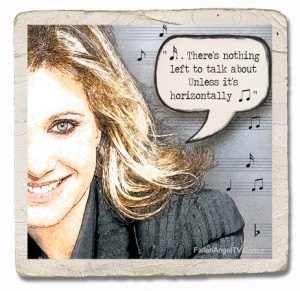
(10/14/13) Music can have a tremendous impact on any sexual experience. As a sensual prompt, some songs can soothe or calm while others can arouse or excite. The basic physiology of this has to do with the natural release of the neurotransmitter dopamine in response to hearing music, causing an increased feeling of enjoyment. There have also been studies that suggest music with a range of beats-per-minute that mimic a natural heartbeat produces elevated enjoyment levels in physical activities. A sense of malaise or boredom may occur with beats in a lower range while someone may feel agitated or tense in response to songs with a higher range.
That said, while the physical part is pretty straightforward, factoring in the emotional is where it gets a little muddled. For many people, music represents a firm psychological trigger–positively for some songs and negatively for others. Advertisers capitalize on this significant detail all the time through their use of jingles (you know–those pesky little earworms that you cannot expunge no matter how many times you spit and spin around). Perhaps it’s emotional manipulation, but it’s also a clear example of how using certain types of music can provoke a specific response. It works with sex the same as it does with Big Macs. (C’mon–you know you know all the ingredients.)
Beyond the obvious need to coordinate musical tastes (since, let’s face it: Not everyone gets off on polkas), it’s often important to consider music that helps synchronize specific moods as well. If one person is feeling mellow while the other is coming off a day-long caffeine binge, this may not be a simple task but it’s pretty obvious that a type of music that normally works well with one mood extreme will likely not have the same effect on a disparate one. Additionally, it’s not a bad idea to think about the lyrics of a potential selection. Many songs have wonderfully sexy melodies but do you really think it’ll be a major turn-on if it features passages with violent or misogynistic fare? All we’re saying is a little preparation goes a long way on this point.
No doubt, it’s an exceptionally individual thing, as it should be with all sexual things, but if you’re looking for suggestions for putting together a “sexy” playlist, there are many places that feature surveys of the “sexiest songs ever” and so forth. The thing is, you’ll be hard-pressed to find any that have a true consensus though many do feature some pretty comical–and occasionally inane–debates about songs that were included/excluded. However, and mostly because we’re so committed to going the extra mile for our beloved readers, we dug deeper just for you and managed to uncover one source that actually had a (somewhat) scientific system for ranking the most popular songs about sex: The American wallet!
Using historical performance (i.e., commercial popularity) data of songs having “something to do with sex” from Billboard Hot 100 lists which have been around since the late 1950s, they came up with the songs listed below. So, with tongue firmly planted in cheek, we present Billboard’s top 10 sexy songs :
10. “Da Ya Think I’m Sexy” – Rod Stewart (1979)
9. “Kiss You All Over” – Exile (1978)
8. “Like A Virgin” – Madonna (1984)
7. “Do That To Me One More Time” – Captain & Tennille (1980)
6. “Hot Stuff” – Donna Summer (1979)
5. “Let’s Get It On” – Marvin Gaye (1973)
4. “Too Close” – Next (1998)
3. “I’ll Make Love To You” – Boyz II Men (1994)
2. “Tonight’s The Night” – Rod Stewart (1976)
And, drum roll—–
1. “Physical” – Olivia Newton-John (1981)
(Incidentally, an irony of the above date pattern is that the data dump used for it is actually fairly recent–compiled after the 2010 stat collection period. While we intended to present the information to illustrate a point somewhat humorously, it does make us wonder–well, a little. How about you?)
